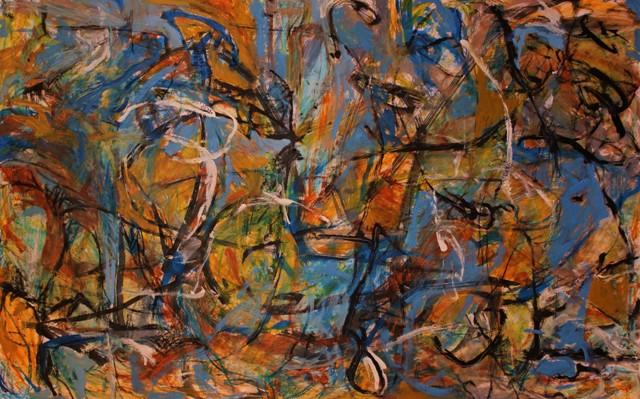“The danger of creating an art which was entirely abstract-and a danger which both Picasso and Braque were fully aware of- was that painting could acquire a purely decorative function. To overcome this, abstraction was made to encompass profound philosophical ideas; and it is significant that the leading abstract painters have had strong mystical leanings. Piet Mondrian was one of the first and most radical of these painters. Beginning his carrier as a straightforward landscapist, he gradually eliminated naturalistic detail in his work so as to create an increasingly simplified and abstract representation of nature. By 1916, however, his art had reached a point where it where it seemingly could go no further. It was then that he encountered a former Catholic priest turned Theosophist, M.H.J. Schoenmaeken, who was propounding a neo-platonic system which he called Primitive Mysticism, or Plastic mathematics.”
What I would like to comment about here, is how the difference between abstract that that has its roots in philosophical understanding about reality and that of abstract that is void of pre-cognized philosophy, has evolved. What were the criteria that led to abstract art as decorative arts and why the latter is recognized to be abstract while in actual fact it is decorative art?
During the Abstract Expressionistic movement of 1950, abstract as an art form gained popularity and was accepted as an investment opportunity amongst the art greats of History. This all happened while overlooking the reasons for the original movement that had its root in the philosophies of perception.
More and more artists found it liberating to break away from traditional approaches of making art and were able to harness the vigorous spontaneity and bold expression of abstraction. Given that many works were executed in large formats, large wall space was necessary for this. The large size of the art works lent themselves to architecturally designed spaces that demanded such size. This could perhaps be one of the reasons why artists rapidly evolved to abstraction without philosophical consideration. The movement created a demand and the demand had to be met. There was no time to get philosophical about art. The artworks became an immediate solution to large vacant wall spaces in buildings and there was an ever increasing public who appreciated the psychological impact of abstract art . This demand may also have contributed to the glamorization of the crazy artist throwing paint around onto huge canvases. The act itself being taken as a performance would trigger off an ideal in the young art students mind.
Art for techniques sake was the general result of the abstract expressionist movement. The originators themselves became the God men of their movement and remain such till this day.
The abstract masters who persued a philosophical approach to their work, were able to explore and convey their findings to their followers who collected their works not only for aesthetical purposes but also for the originality of exploring the frontiers of perception. Those that did not, were left with technique and an academic approach to art. Their newly born movement was nothing more than something out of the ordinary that challenged the way in which artists worked their canvases.
So we have the two approaches to abstract. The latter, heralding the pop art movement as the demand for decoration took presidency.
Now in the 21st century, abstract art is by far one of the popular hot spots in the art world. Its aesthetical impact is what gets the work sold. And sell they do. High prices are sought for abstracts and if the artist can conjure up a recipe that meets the public eye, their careers are made. Not only this, but the ground is also prepared for a fast rollercoaster ride because the colours of this year may not be in demand next year. The size of canvas is also pre-set. This size can fit above that size seated couch etc.
I call this, supermarket abstract and a lot of these are not necessarily bad either. There are some excellent abstract artists about these days, really exploring diverse ways of expression. But I ask myself often what are they saying other than being able to get the paint down in one style or another. And does it matter if the philosophy behind the art work is not available?
If we were to look at our art history (I’m basing this on western art history which is understandably not the only art history), we can see that it was the philosophy of perception that distinguished abstract art from abstract decoration. That the artist delved within, so to speak, and through this sought to understand the inner workings of nature. And that out of this evolved the expression of abstract.
If present day abstract artists were to follow through with where the first abstract artists left off, then we would be taking abstract art into the 21st century as contemporary abstract. If not, the original movement will continue to burn a dim light amongst the colourful surroundings of decoration taken to be art.







Comments 1
Say something